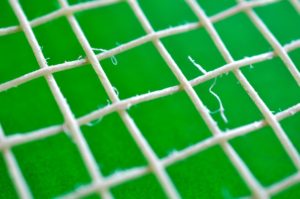
There is no question that natural gut tennis string is the best overall tennis string for most tennis players.
It holds tension remarkably well and over a very long period of time; this makes it a great value. It is a natural fiber taken from animals, therefore it more closely matches the materials in the human shoulder and elbow than nylons and polyesters mixed in a vat and extruded in a lab; this makes natural gut a safer and healthier choice for most athletes. And finally, because it has more elasticity than virtually all polyesters, it offers players who need it a lot more power and playability than artificial strings.
The downside to natural gut, many players will tell you, is the price. While it may offer health benefits and environmental benefits (it is organic animal tissue), these benefits are not free. On average, natural gut costs two to three times more per racquet with than with multifilament. So for frequent string breakers, stringing with natural gut can get to be quite expensive.
Our experience at Racquet Network is that most tennis players at the beginner and intermediate levels are satisfied with natural gut. The customers who are least satisfied with gut are men under 40 who like to pound the ball, especially on their serves. While these players probably should not be pounding serves (the harder they hit, the more they miss), they tend to do it anyway. More importantly, they like to do it. In fact, they consider pounding serves and ground strokes to be an important part of their game.
Pounders, whether on the serve or from the baseline, go through string of all kinds a lot faster than placers (players who place the ball, rather than pound it). And the lower their skill level, the faster pounders go through string.
This pattern of frequent string breakage is often a function of unnecessary power coupled with inconsistency. While more advanced players hit the ball in the center of the string bed on more than 80% of their shots, intermediate players hit the center of their racquet only about half of the time. When intermediate pounders hit off center, it means that the strings along the grommet line are being subjected to an extremely high amount of force and are more likely to break.
This combination of wasted power and off-center ball strikes makes natural gut seem like an expensive choice for intermediate pounders. Players is this category tend to believe that they are better off with polyester strings than natural gut because they perceive breakage as their most important problem. The question is whether or not this is actually the case.
Poly strings are durable. There is no question about that. A 16 gauge polyester string may last some players for years. Unfortunately, there is a downside to this durability that most players don’t realize. First, polyester strings lose power very quickly, even if the racquet is sitting in your bag doing nothing; this means that you need to restring every three or four weeks, even when you are not playing. Second, poly string is a lot stronger than most of the tissues in your shoulder and elbow; therefore if you subject both to equal amounts of stress, it is your body that will break, not the string. Finally, there are environmental costs to consider because polyester molecules take thousands of years to break down and be reabsorbed by nature.
So while polyester strings may seem to offer a better value than organic strings, the trade offs have to be considered before that can actually be determined. Is it smart to use polyester string so that you can pound serves that end up going wide anyway? Is it smart to use a string that helps your serve but kills your volleys and ground strokes? Is it smart to choose a polyester string that will likely go dead before you have a chance to use it again?
As any good coach will tell you, things are not always what they seem. Broken strings could be a sign that you need stronger strings or they could be a symptom of weakness in your strokes. Before you allow a broken string to knee jerk you into using strings created for professional players maybe you should consider all of the factors at play. You should also be aware of the fact that many of the pros who use poly only use it once before re-stringing their racquets and they almost never have to pay for it.